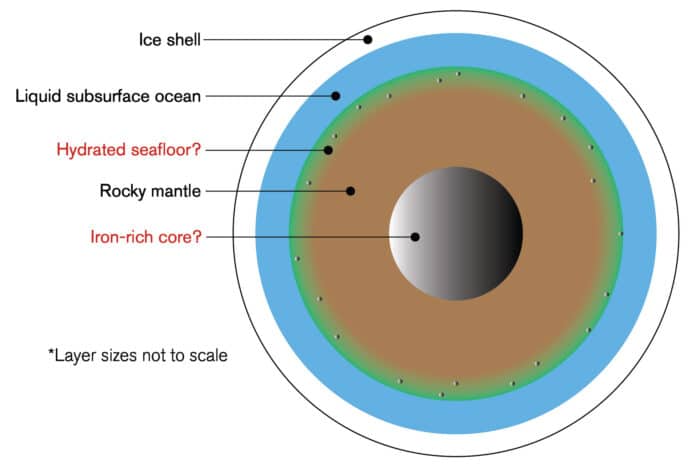Jupiter’s moon, Europa, is of particular interest to scientists. It has been found to offer a habitable environment for some form of life beyond Earth. Also, it is believed to be made of four layers: an ice shell, saltwater ocean, rocky mantle, and metallic core.
Many argue that Europa’s interior, like Earth, is differentiated into a metallic core and a mantle composed of anhydrous silicates. Some studies further assumed that Europa differentiated, like Earth, while (or soon after) accreted. However, Europa probably formed at much colder temperatures, meaning that Europa plausibly ended accretion as a mixture containing water-ice and/or hydrated silicates.
Utilizing computer code that Kelvin Trinh (a graduate associate at ASU’s School of Earth and Space Exploration) created, researchers- from Arizona State University, including Carver Bierson, Joe O’Rourke, and the School of Earth and Space Exploration- examined the effects of Europa’s formation at low initial temperatures.
Though some researchers made this assumption, Trinh and his team demonstrate that if Europa did originate from hydrated rocks (rocks that contain both hydrogen and oxygen), then enough of the planet’s interior would have warmed up to cause the hydrated rocks to release water directly, creating the ocean and ice shell.
Trinh said, “The origin of Europa’s ocean is important because the moon’s potential to support life ultimately depends on the chemical ingredients and physical conditions during the ocean formation process.”

Numerous researchers who studied this icy moon assumed that Europa developed a metallic core during or shortly after accretion. According to this ASU study, which disputes that assumption, Europa may not have begun building its metallic core until billions of years after accretion (assuming it occurred).
Carver Bierson, a postdoctoral research scholar at ASU’s School of Earth and Space Exploration, said, “For most worlds in the solar system, we tend to think of their internal structure as being set shortly after they finish forming. This work is very exciting because it reframes Europa as a world whose interior has been slowly evolving over its whole lifetime. This opens doors for future research to understand how these changes might be observed in today’s Europa.”
The internal heat of Europa, which may also be utilized to fuel seafloor volcanism and contribute to a livable seafloor environment, is intimately linked to the existence of a metallic core. It is uncertain, though, whether Europa produced enough heat to create such a core.
Trinh’s code uses the same governing equations that many geodynamicists have used for decades to determine how heat is generated and distributed throughout a moon. However, the team’s innovative discovery results from questioning the fundamental hypotheses of Europa modeling: A tiny moon like Europa might have originated as a cold mixture of ice, rock, and metal.
This study implies that there may be limited hydrothermal activity and seafloor volcanism at Europa, which may hinder habitability. However, confident predictions require more data.
Journal Reference:
- Kevin Trinh, Varver Bierson, Joseph O’Rourke. The slow evolution of Europa’s interior: metamorphic ocean origin, delayed metallic core formation, and limited seafloor volcanism. Science Advances. DOI: 10.1126/sciadv.adf3955
